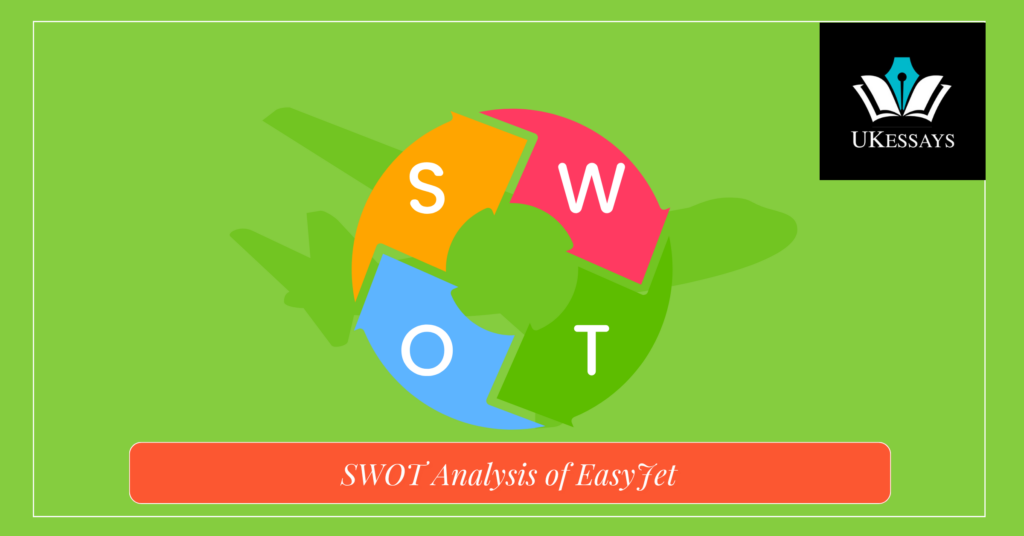SWOT Analysis of easyJet
Info: 899 words (4 pages) SWOT Examples
Published: 31 Jul 2019
Part of: SWOT Analysis
Introduction to our SWOT Analysis of EasyJet
This SWOT analysis of EasyJet provides an overview of a leading provider of low-budget, no frills air travel. To date, EasyJet strengths include its services to regional and some international airports throughout the UK as well as many cities in Europe. Accordingly, the low-cost airline model has found a niche in recent years. In essence, the brand holds a strong market share in competition with legacy airlines throughout the UK and Europe.
However, changing market conditions in the airline industry are a strong signal that EasyJet weaknesses need to be heeded. Accordingly, our EasyJet SWOT analysis can help them consider its strengths, weaknesses, opportunities and threats. As a result, EasyJet can refine its strategy going forward and maintain its position.
EasyJet Strengths
- EasyJet has developed a brand reputation for the cheapest flights in the UK and Europe, especially among young travellers and some business people.
- They offer a reliable, on-time travel service with value-added features that include online booking, ticketless travel, and travel services.
- EasyJet has been adding new modern planes to its fleet to ensure safety, reliability, and even emissions reduction.
- Their website is easy to use and facilitates ticket purchases.
- They focus on customer loyalty by offering online sales alerts to email and text.
- EasyJet has a clear corporate social responsibility programme with initiatives geared toward reducing the company’s impact on the environment.
- They are known for their efficient and friendly customer service despite being a no-frills airline.
- EasyJet has added many routes and has expanded its routes throughout Europe to serve more customers and offer more flight times.

EasyJet Weaknesses
- The low-cost airline industry is extremely competitive with numerous brands fighting for the same customer base. This has led to price wars and other strategies that make it difficult for EasyJet to keep up due to concern over costs involved in trying to slash prices further or offer any frills.
- Competition is now increasing from legacy carriers who have altered their business models and begin offering lower prices with frills for the same routes as EasyJet.
- They do not offer a free food service on longer flights of more than two hours, which many customers find difficult.
- The service format does not cater to a wide demographic as many older travellers do not like the party atmosphere on EasyJet planes that are most often taken by young, rowdy travellers going away for school holidays or weekend party trips. This format alienates many demographics that EasyJet could be serving.
Opportunities
- The airline could expand its route system further into new regional markets throughout Europe and cater to specific customer segments.
- EasyJet could offer travel packages with tours that also attract certain travellers who are seeking specific kinds of travel experiences.
- The airline could look at ways to make its overall operating framework more efficient so that it could offer some perks so that it became more competitive. Recently, the airline has announced that it would be adding more frills, which is a significant opportunity where EasyJet could further differentiate itself.
- EasyJet could look for strategic partnerships with airports to help expand its route system and offer more travel options for its customers.
- The business segment of travellers could become a focus as there is an ongoing need for business travel that is less influenced by changing economic cycles. Creating routes and services directed at business travellers could provide a significant opportunity for the airline.
Threats to EasyJet
- Increased airport fees are a threat to EasyJet in terms of reducing the margin that the airline can compete on as it is a cost that the company cannot control or change unless it can negotiate with these airports and reach an agreement on lowering the airport fees. Otherwise, it may have to shut down certain routes, which could further threaten business sustainability.
- Competitors are offering more frills, flights, and route options whilst still maintaining a low cost, which can also threaten EasyJet’s position in the market.
- External market forces are a threat in terms of cost pressures associated with the rising cost of oil, environmental expectations, and economic recessions that reduces the number of flights taken by leisure travellers.
- Internal factors are also a threat in terms of labour unions and employee strikes, demanding more money or benefits. This can also add to EasyJet’s cost structure and put more pressure on the airline to potentially raise prices.
- Legacy airlines are becoming a greater competitive force in the airline industry as they seek to sustain themselves with a focus on service and features, which puts more pressure on EasyJet to increase its service focus without adding to its cost structure.
References for SWOT Analysis of EasyJet
- easyJet plc (2021) Annual Report and Accounts for the year ended 30 September 2021. Available at: https://corporate.easyjet.com/files/doc_financials/2021/ar/annual-report-2021.pdf [Accessed 31 May 2025].
- Marketing91 (2024) SWOT Analysis of EasyJet (Updated 2025). Available at: https://www.marketing91.com/swot-analysis-of-easy-jet/ [Accessed 31 May 2025].
- Osum (2024) Unveiling the Strategic Analysis: EasyJet. Available at: https://blog.osum.com/easyjet-strategic-analysis/ [Accessed 31 May 2025].
- International Civil Aviation Organization (ICAO) (2023) Presentation of 2021 Air Transport Statistical Results Annual Report. Available at: https://www.icao.int/annual-report-2021/Documents/20230320_Final_Table_en.pdf [Accessed 31 May 2025]
- Grand View Research (2021) COVID-19 Impact On Civil Aviation Industry Report, 2021-2028. Available at: https://www.grandviewresearch.com/industry-analysis/civil-aviation-industry-report [Accessed 31 May 2025].
- Business Model Analyst (2025) EasyJet SWOT Analysis. Available at: https://businessmodelanalyst.com/easyjet-swot-analysis/ [Accessed 31 May 2025].
Cite This Work
To export a reference to this article please select a referencing stye below:
Related Services
View allRelated Content
CollectionsContent relating to: “SWOT Analysis”
Related Articles



